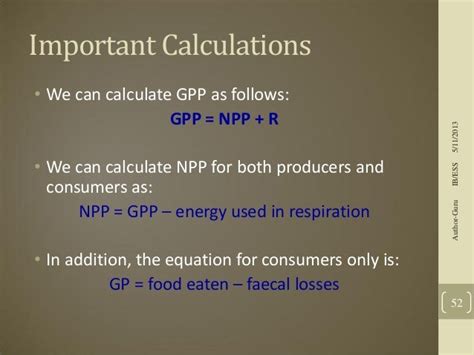Understanding Net Primary Productivity (NPP)
Net primary productivity (NPP) quantifies the rate at which an ecosystem produces organic matter through photosynthesis. This fundamental metric provides insights into the health and carbon sequestration potential of ecosystems, particularly in the context of global change.

Methods for Calculating NPP
1. Field Measurements:
- Harvested Biomass: Directly measure the increase in biomass (e.g., plant weight) over a specific time period. However, this method can be labor-intensive and destructive.
2. Eddy Covariance Method:
- Utilize eddy covariance towers to measure the net exchange of carbon dioxide and water vapor between the ecosystem and the atmosphere. This method provides continuous real-time data but requires sophisticated equipment and expertise.
3. Remote Sensing Data:
- Employ various satellite remote sensing techniques to estimate NPP based on measurements of vegetation indices (e.g., NDVI) and environmental factors (e.g., temperature, precipitation). This method is non-invasive and provides spatial and temporal coverage.
Remote Sensing-Based NPP Estimation
Remote sensing techniques have become increasingly popular for NPP estimation due to their efficiency and coverage. The following table summarizes the commonly used approaches:
| Approach | Data Source | Advantages | Disadvantages |
|---|---|---|---|
| Vegetation Indices | Satellite imagery | Simple and widely applicable | Saturation effects in dense vegetation |
| Light Use Efficiency Models | Satellite imagery and climate data | Account for environmental factors | Require parameterization |
| Machine Learning Models | Satellite imagery and ancillary data | Can handle complex relationships | Data-intensive and computationally expensive |
Data Sources for Remote Sensing-Based NPP Estimation
Numerous remote sensing data sources are available for NPP estimation, including:
1. Moderate-Resolution Imaging Spectroradiometer (MODIS):
* Provides global coverage of vegetation indices with a 500-meter resolution.
2. Landsat:
* Offers high-resolution satellite imagery (30-meter resolution) for localized studies.
3. Sentinel-2:
* Provides free and open-access multispectral data with a 10-meter resolution.
Applications of NPP Data
NPP data has a wide range of applications, including:
- Monitoring ecosystem health and resilience
- Assessing carbon sequestration potential
- Predicting ecosystem responses to climate change
- Modeling the impact of land use changes on ecosystem productivity
Future Directions and Emerging Technologies
- High-Throughput Phenotyping: Using drones and automated image analysis to measure plant traits related to NPP.
- Artificial Intelligence-Driven NPP Estimation: Leveraging machine learning to improve accuracy and efficiency of NPP estimation from remote sensing data.
- Integration with Ecological Models: Incorporating NPP data into ecosystem models to simulate and predict ecosystem dynamics.
Conclusion
Calculating NPP is crucial for understanding ecosystem productivity and its implications for ecosystem services and climate change. Researchers employ various methods, including field measurements, eddy covariance, and remote sensing techniques. Remote sensing-based NPP estimation has gained prominence due to its efficiency and spatial coverage, utilizing data sources such as MODIS, Landsat, and Sentinel-2. NPP data has a wide range of applications, and ongoing research continues to drive innovative techniques and applications, expanding our knowledge of ecosystem functioning and its response to environmental changes.
